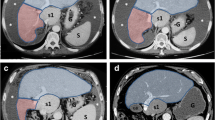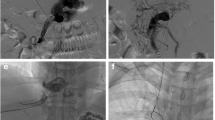Abstract
Liver cirrhosis is frequently complicated by spontaneous portosystemic shunt (SPSS) due to portal hypertension. Shunt embolization is considered when symptoms related to SPSSs are refractory to endoscopic and/or medical therapies. However, little information is available on the treatment of patients with multiple and large SPSS. We report a successfully managed case in which patient with such SPSS received two embolization procedures within 6 months. A 57-year-old man with alcoholic liver cirrhosis was transferred to our hospital due to a ruptured gastric varix. CT examination showed gastrorenal and splenorenal shunts of 8 mm and 11 mm in diameter, respectively. In addition, multiple hepatocellular carcinomas (HCCs) were noted. First, balloon-occluded retrograde transvenous obliteration (BRTO) was performed for the gastrorenal shunt, resulting in the disappearance of the varix, followed by transcatheter arterial chemoembolization (TACE) for HCCs. However, the hepatic encephalopathy worsened after the BRTO and TACE, and the splenorenal shunt enlarged to 18 mm in diameter. Although the shunt was tortuous and had another drainage vein, we completed the embolization for the shunt using metallic coils without any events. The patient’s hepatic encephalopathy and hepatic function were ameliorated after embolization for the splenorenal shunt, and the patient was free from hepatic encephalopathy.




Similar content being viewed by others
References
Simón-Talero M, Roccarina D, Martínez J, et al. Association between portosystemic shunts and increased complications and mortality in patients with cirrhosis. Gastroenterology. 2018;154:1694–705 (e4).
Nardelli S, Riggio O, Turco L, et al. Relevance of spontaneous portosystemic shunts detected with CT in patients with cirrhosis. Radiology. 2021;2021:203051.
Lee EW, Lee AE, Saab S, et al. Retrograde transvenous obliteration (RTO): A New Treatment Option For Hepatic Encephalopathy. Dig Dis Sci. 2020;65:2483–91.
Praktiknjo M, Simón-Talero M, Römer J, et al. Total area of spontaneous portosystemic shunts independently predicts hepatic encephalopathy and mortality in liver cirrhosis. J Hepatol. 2020;72:1140–50.
Vidal-González J, Quiroga S, Simón-Talero M, et al. Spontaneous portosystemic shunts in liver cirrhosis: new approaches to an old problem. Therap Adv Gastroenterol. 2020;13:1756284820961287.
Ishikawa T, Hamamoto K, Sasaki R, et al. Significant improvement in portal-systemic liver failure symptoms and successful management of portal-splenic venous hemodynamics by the combination of interventional radiology and pharmacotherapy. Hepatol Res. 2020;50:1201–8.
Miyamoto Y, Oho K, Kumamoto M, et al. Balloon-occluded retrograde transvenous obliteration improves. J Gastroenterol Hepatol. 2003;18:934–42.
Ishikawa T, Sasaki R, Nishimura T, et al. Comparison of patients with hepatic encephalopathy and those with gastric varices before and after balloon-occluded retrograde transvenous obliteration. Hepatol Res. 2018;48:1020–30.
Scheiner B, Ulbrich G, Mandorfer M, et al. Short- and long-term effects of transarterial chemoembolization on portal hypertension in patients with hepatocellular carcinoma. United European Gastroenterol J. 2019;7:850–8.
Inoue M, Tanaka T, Nakagawa H, et al. Splenic Vein Embolization Using Coil Anchors and Prophylactic Occlusion of a Hepatofugal Collateral for Hepatic Encephalopathy due to Splenorenal Shunt: Technical Note and Literature Review. Case Rep Radiol. 2013;2013:160653
Author information
Authors and Affiliations
Corresponding author
Ethics declarations
Conflict of interest
All authors (Wataru Ueno, Naoto Sato, Kouichi Miura, Naoki Morimoto, Shunji Watanabe, Hiroaki Nomoto, Norio Isoda, Shigeyoshi Kijima, Tomohiro Kikuchi, Saki Manaka, Harushi Mori, and Hironori Yamamoto) have no conflict of interest.
Human Rights
All procedures followed have been performed in accordance with the ethical standards laid down in the 1964 Declaration of Helsinki and its later amendments.
Informed consent
Informed consent was obtained from the patient for being included in the study.
Additional information
Publisher's Note
Springer Nature remains neutral with regard to jurisdictional claims in published maps and institutional affiliations.
Rights and permissions
About this article
Cite this article
Ueno, W., Sato, N., Miura, K. et al. Successful control of portal hypertension-related complications after two embolization procedures for multiple and large spontaneous portosystemic shunts in a patient with liver cirrhosis. Clin J Gastroenterol 14, 1227–1232 (2021). https://doi.org/10.1007/s12328-021-01441-3
Received:
Accepted:
Published:
Issue Date:
DOI: https://doi.org/10.1007/s12328-021-01441-3




